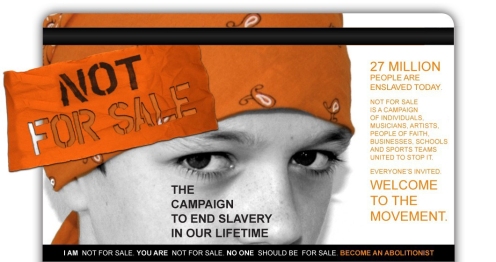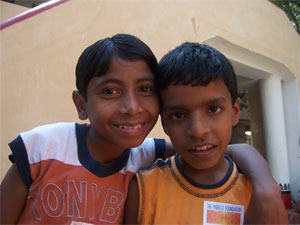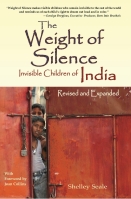Monthly Archives: February 2008
The Essentials of Being
 India has her hooks in me like an old lover — an old lover who you’ve told yourself that you never want to be with again but who keeps re-appearing like a hungry ghost tapping on your shoulder, and no matter how fast you run you can never escape him because he is a part of you forever.
India has her hooks in me like an old lover — an old lover who you’ve told yourself that you never want to be with again but who keeps re-appearing like a hungry ghost tapping on your shoulder, and no matter how fast you run you can never escape him because he is a part of you forever.
You know this and you hate it but you love it all at the same time.
This was written by Linda Karl on her blog, Linda’s Yoga Journey. I love it, because it makes me smile with humor and wistfulness at the same time; and because the comparison is oh, so true. I have been thinking a lot about what it is that draws so many people to India – often the same things that repulse others. I can only answer that for myself.
India’s rawness of life strips away the unnecessary – distractions, superficial attachments, trivial worries. Without this safety net life becomes fundamental, only the essentials of being, and causes you to be fully present in your own existence. You become lost, in order to find. Revealed are not only the blemishes and horrors of the country that might be recoiled from – abject poverty, child beggars, humans sleeping in the street like animals – but also revealed are the blemishes within ourselves, stains on our own souls. At home, these things are hidden neatly away as much as it is possible to do so.
But in India, everything is in full view; nothing is hidden. If I am repulsed without feeling compassion, my character is lessened; if I am aghast without recognizing the inequitable and appalling facets of my own culture, it is a reflection of my own true self; if I run away because it is selfishly easier than facing reality, it leaves a gaping hole in my connection to the human condition, that cloth of which we are all a part.
India shows us where our suffering lies, and in this way becomes more than anything else a teacher, if only we are open to learn from her.
————————————————-
In other news, the wonderful blog Surface Earth made a very nice posting about my site, as well as some other inspiring stories of people of change and hope around the world. I hope you’ll take a minute to check it out:
http://surfaceearth.wordpress.com/humanitarian-news-updates/
Children For Sale on Craigslist

I’m sure most of us are familiar with Craigslist, an online Web community where people post job opportunities, items for sale, and find activity partners. Over the past years, Craigslist has grown by leaps and bounds and now has Web sites representing over 300 U.S. cities. However, despite its millions of users and various social benefits, there’s a dark side of Craigslist that most users don’t see. In the “Erotic” section, human traffickers have found Craigslist to be one of the most efficient, effective (and free) ways to post children and women for sale.
This happens in the United States every day, as well as Europe, Africa and Asia.
Katherine Chon, Executive Director of the Polaris Project, wrote the following on Not For Sale, the campaign to end slavery in our lifetime:
“With a bit of research, one can realize just how much of a problem this has become. In one recent case, two Chicago women were charged for selling girls as young as 14 years old on Craigslist. The girls were forced to have sex with 10-12 men per day, and the traffickers made tens of thousands of dollars. A Boston man and his niece were charged with plotting a child trafficking operation with teenagers as young as 13 by selling them on Craigslist to predators from Massachusetts to New York. These cases are just the tip of the iceberg. In fact, law enforcement efforts to fight trafficking nationwide are consistently reporting a spike in online Craigslist ads, and how sex trafficking has “moved online” lately.
In Washington, DC, we see an average of 500 of these such Craigslist ads each new day. Yet, it is important to realize that a significant percentage of these ads on Craigslist do not advertise solely “legal escort services” as Craigslist may like to believe. Instead, a considerable percentage of the ads are a thinly veiled guise for one of the many faces of human trafficking that exists here in the United States. Although Craigslist may convince itself that it has created a beneficial online venue for advertising legal escorts, in effect, what it has done is create a fertile ground for traffickers to further their trade in human misery.
Many of the victims of human trafficking that Polaris Project has served have had their pictures posted on Craigslist. Through serving them, we’ve learned how the pictures on Craigslist hide the pain behind the smile. Maybe Craigslist should ask itself if the marginal benefits of this form of free advertising for the sex trade are worth the far larger human costs.”
 Don’t fool yourself into thinking that slavery is a thing of the past, part of the terrible history of the formation of the United States or something that we can read about in our history books and shake our head with sorrow and regret. Slavery is alive and well today. 27 million people are currently enslaved.
Don’t fool yourself into thinking that slavery is a thing of the past, part of the terrible history of the formation of the United States or something that we can read about in our history books and shake our head with sorrow and regret. Slavery is alive and well today. 27 million people are currently enslaved.
You are not for sale. I am not for sale. No one should be for sale. Become an modern-day abolitionist. Join the fight against slavery.
Give the Gift of True Love this Valentine’s Day

Valentine’s Day is coming up, the time for celebrating love. As we do so, what better way to show love than to do so toward those who desperately need it. Instead of the boring, traditional Valentine’s ideas, how about one of these unique gift ideas that will show your special someone that you care, not only about him or her but also about the world at large.
Flowers
Were you going to send flowers to your sweetheart this year? These bouquets from Organic Bouquet are not only eco-friendly, but they come with a complimentary vase. Plus, 10% of any purchase benefits school girls in Mozambique.
Jewelry
Nightlight Jewelry is handcrafted in urban Bangkok by women who have escaped the sex trade industry. Jewelry sales offer these women a sustainable income and the freedom to have a livelihood of joy and dignity.
Gift Cards
Send your Valentine a GlobalGiving gift card. Send them online or through the mail, and choose our “Give Love” card design for a special touch. Show your Valentines how much you care by giving them a chance to make a difference.
How to Get 100 Million Children in India Reading
“Santosh is one of the boys.”
I looked at Papa in surprise. Shortly before leaving India, he and Caroline and I sat under the shade of the mango tree while he related to us the difficulties he was having with some of the adolescent boys. A group of them were going off to classes in the morning, but then sneaking back into the ashram shortly thereafter to play or nap. It had been occurring on a fairly regular basis, exasperating both Papa and the staff.
 “Santosh?” I questioned. “He’s been skipping school?”
“Santosh?” I questioned. “He’s been skipping school?”
“Hai, yes,” Papa said. “I don’t know what to do. We don’t have enough people to watch every child every minute. I tell them they must get their education…” He trailed off, raising his hands in a gesture of defeat.
I glanced at Caroline. Part of me wanted to laugh a little, at the image of this small band of renegade boys pulling a Huckleberry Finn to have a good time. But of course I did not want to make light of the problem, and was well aware of the importance of an education for all these kids. Their futures had been compromised enough with the odds they already had stacked against them: abandonment or orphanhood, poverty, caste. Without a good education the future grew much bleaker. It was their ticket out.
“Do you think I should talk to Santosh?” I asked both Caroline and Papa.
Papa nodded his head vigorously. “I have talked, and still they are doing this. He will listen to you.”
I had halfway hoped Papa would decline my offer. Until then I had been the fun aunt who only had to play games and have a good time and bring treats. But it was a long-term relationship I had embarked on, not only with Santosh and Daina but with all the children, and Papa as well. I knew that going into it, and now the time had come for the aspect of the adult/guardian role that was not so fun – the arm of discipline. I was going to have to be the bad guy.
Later that day there was a lull in the activities and I pulled Santosh aside for a quiet moment. His English had improved but was still limited, so I needed to make sure he understood. “How is school?” I began.
“Good.”
“Do you study hard?”
“Yes.”
“What do you want to be when you grow up?”
Santosh thought about this for a moment. “A dancer,” he said. I suppressed a smile at the memory of him dancing in the mosh pit party when we’d first arrived. Like most children, his adult career plans changed with regularity; when I’d first met him, he wanted to be a painter. In one letter to me he’d written that he wanted to be a soldier when he grew up.
I paused, choosing my words carefully. “Papa tells me that sometimes you don’t go to school.” Santosh looked down, not meeting my eyes. He seemed embarrassed that I knew this; it had not occurred to him that Papa might tell me.
“Papa said that you and some other boys leave school and miss classes,” I continued. “You know that school is very important, don’t you?” His nod was an almost imperceptible movement. “You need to go to school every day, Santosh. You need to study hard and do well in school to be a dancer when you grow up. You need to know your English well so you can be anything you want to be.”
He nodded again, but was clearly sulking at the reprimand. The last thing I wanted was for him to feel bad or think I was mad at him, so I put my arm around his shoulders and hugged him to me. “You’re a very smart boy, Santosh. Do you know that? You are very smart. You can do anything you want to. I’m very proud of you, and it will make me happy if you go to school every day and work hard.”
 Santosh continued to look at the ground. I patted his back. “You will go to school every day, and not leave classes? You will study hard?” He nodded. “Okay. Do you want to get my camera and take some pictures?” I stood up.
Santosh continued to look at the ground. I patted his back. “You will go to school every day, and not leave classes? You will study hard?” He nodded. “Okay. Do you want to get my camera and take some pictures?” I stood up.
He loved snapping photos with my camera, and I sometimes entrusted it to him as my “official photographer.” He smiled and perked up, and I took his hand. “Come on, let’s go.”
* * *
The difference that an education, literacy and competency in English makes in the future of a child cannot be overestimated – especially a marginalized or disadvantaged child; a child like Santosh. One of the main factors that makes children vulnerable to street life, trafficking, early marriage, child labor or adult unemployment is lack of education. And education of its children remains one of India’s greatest challenges as a country. Approximately a hundred and thirty-seven million Indian children – nearly half the entire population of the United States – are illiterate. In the six to fourteen year age group, thirty million cannot read at all, forty million recognize only a few letters, and forty million can read some words. Over fifty-five million of these children will not complete four years of school, eventually adding to the illiterate population of India – the largest of any country in the world.
The World Bank Group has a terrific blog devoted to Ending Poverty in South Asia. The blog is maintained by Shanta Devarajan, Chief Economist of the South Asia Region at the World Bank. Its goal is to create a conversation around how South Asia can end poverty in a generation.
Last year an article appeared on their site that asked the question:
How do you go from a rural India in 2006 in which:
– close to half the children in grade 1 could not recognize numbers or letters
– almost half the children in grade 2 could not read a grade 1-level text fluently or do a 2-digit subtraction problem confidently
– about half the children in grade 5 could not read a grade 2-level text easily or do a simple division problem
to a situation by 2009 in which:
– all grade 1 children know at least the alphabet and numbers
– all grade 2 children can read at least simple words and do simple sums
– all grades 3-5 children can at least read simple texts fluently and solve arithmetic problems confidently
And do it for a target population of almost a 100 million children?
The article goes on to focus primarily on an initiative called Read India that was launched by Pratham, a nonprofit organization devoted to the education and literacy of India’s children. I have written about Pratham in my book as well:
When families struggle to feed themselves and even clean water remains painfully scarce, education plays a minimal, too often expendable, role to many of India’s poor. Organizations like Pratham employ a preventative approach to decrease the vulnerability of children living in such poverty to ending up on the streets, trafficked or in child labor. Originally parented by UNICEF in 1994, Pratham began in Mumbai slums where the learning program reaches about thirty thousand children each year with literacy efforts, preschools, computer classes and teacher training. It quickly expanded to Delhi and other cities, launching a nationwide program called Read India in 2002 with a mission of “every child in school and learning well.”

An incident in a Delhi slum called Zakhira demonstrates the difficulty that children living in these areas often face just getting to school. Zakhira is an illegal shantytown balanced precariously – and dangerously – in a triangle formed between three train tracks. Trash and defecation clog the tracks where trains speed by mere feet from corroding tin and plastic homes. Not long ago a young child was run over and killed by a train as he followed his mother to school. When the police came, the grieving mother had to deny the child was hers to avoid prosecution for endangering the lives of passengers on the train.
Other students must cross these very same tracks to attend the nearest school, a risk that most parents don’t allow. The largely migrant families that make up Zakhira rarely stay for more than a few months. These challenges, coupled with the great poverty, make many parents reluctant to send their children for an education. When Pratham set up their program in this area in 2005, many members of the organization saw the Zakhira venture as one of its most difficult and wondered if the possibility to teach anything substantial there even existed. Slow improvements have come, however. Children who previously knew nothing of India’s Independence Day now celebrate in Zakhira’s own commemoration festival. The community was soon swarming with children able to count and read the Hindi alphabet; seemingly small accomplishments, but something few in the area could do before.
* * *
A few weeks after I returned home from that visit with Santosh, I received a letter from him. He talked about the fun of the visit, sent wishes for our good health, and asked Chandler to write him a letter. He also wrote:
“Now I am appearing for my annual exam. We’ll get summer vacation next month. I’ll let you know my academic result on my next letter. You are right that education is very important for me. Lovingly yours, Santosh.”

